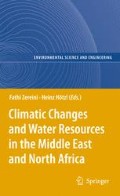Abstract
As a global meteorological process, change in climate conditions has become a serious topic that many researchers work on. However, data availability is still the major problem to analyze this process. Lebanon, as a Mediterranean region is influenced by climate change, which is viewed not only from fluctuation in the climatic elements, but also from its influence on the regime of water resources. These resources show an abrupt volumetric decrease in water supply, the so-called ,,hydrologic drought". Thus accusation of water shortage has become a national issue. The study of this phenomenon is tackled through analyzing different indices of surface and subsurface water, thus comparing different records on graphical illustrations and numeric values. Results of this application in Lebanon revealed an obvious decline in the amount of available water. This decline shows a variance between different sources. However, those which are not in a direct touch with human, like precipitation and snow cover, are less influenced and a decrease of 12- 16 % was resulted. These two elements directly represent the climate impact on water inputs. While, this percentage gets higher in the case of rivers and groundwater, in which their decrease ranges between 23-29 %. This adds the human interference to the climatic conditions, which is due to over exploitation form groundwater and rivers. Moreover, the number of springs and their discharge as well as the number of local reservoirs exhibits the most excessive influence, Consequently, it was reduced to 43 % and 79 % for the springs and local reservoirs; respectively. This high percentage is attributed to the dependence of human on these two sources. The obtained results in this study are quite alarming and expose a dramatic exceed in the level of hydrologic drought in Lebanon that would be worth taking decision as soon as possible to water conserve by following a wise-use of water resources.
Access this chapter
Tax calculation will be finalised at checkout
Purchases are for personal use only
Preview
Unable to display preview. Download preview PDF.
References
Amery, H. and Wolf, A. 2000. Water in the Middle East: A geography of peace. University of Texas Press.
CAL, 1982. Atlas Climatique du Liban, Tome II. Service Météorologique, Ministère des Travaux publics et Transports, 31p.
CNRS. National Council for Scientific Research. 2007. Final Technical Report on the project: Towards an ecosystem approach to the sustainable management of the Litani River-Lebanon. IDRC & CNRS & LRA and DSA.
DGAC, 2006. Direction Générale de l’Aviation Civile, rapport annuel, Beyrouth, Liban, 32p.
El Moujabber M., Darwish T., Shaban A., Atallah Th., Abi Saab M., and Janho R. 2005. Regional water balance as a tool to monitor groundwater contamination by seawater intrusion on the Lebanese Coast. International Conference on Water, land and Food Security in Arid and Semi-Arid Regions. Mediterranean Agronomic Institute of Bari. 6-11 September, Groundwater management: 1-13
FAO, 1972. Project de développement hydro-agricole du Liban. Thermometric aéoroportée par infrarouge.
Gibbs, W.J.; and J.V. Maher. 1967. Rainfall deciles as drought indicators. Bureau of Meteorology Bulletin No. 48, Commonwealth of Australia, Melbourne.
Meinzer, E., 1923. Outline of groundwater hydrology with definitions: USGS WateSupply Paper, 494p.
Hachache, A. 1993. Origin of water salinity in the coastal Sarafand aquifer (South Lebanon). ONL. Proc. National Conference on Water. Ministry of water, Beirut.
Hamdy, A. and Lacirignola, C. 2005. Coping with water scaricity in the Mediterranaen: What,why and how?. CIHEAM Publishing Bari, Italy. 739p.
Khawlie, M., Shaban, A. and Darwich, T. 2003. Saltwater intrusion in Beirut groundwater and the possibilities to reduce its impact. A conference on Saltwater management and treatment in Beirut area. ESDE, Beirut, Lebanon, 19th Dec, 2003.
Lababidi, H., Shatila, A. and Acra, A. 1987. The progressive saliniation of groundwater in Beirut. Int.Journal of Environmental Stidies. 30:203-208.
LRA (Litani River Authority). 2006. Rivers discharge. Technical information support. LRA, Beirut, Lebanon.
NCRS, 1997. TIR survey for fresh water resources on the marine environment along the coastal stretch of Lebanon. National Council for Scientific Research. National Center for Remote Sensing, Beirut, Lebanon.
Palmer, W.C. 1965. Meteorological drought. Research Paper No.45. US Weather Bureau. NOAA Library and Information Services Division. Washington, D.C. 20852.
Redmond, Kelly, 1991, Climate monitoring and indices, in Wilhite, D.A., Wood, D.A., and Kay, P.A., eds., Drought management and planning: International Drought Information Center, Department of Agricultural Meteorology, University of Nebraska-Lincoln, IDIC Technical Report Series 91-1, p. 29-33.
Shaban, A. 2003. Etude de l’hydroélogie au Liban Occidental: Utilisation de la télédétection. Ph.D. dissertation. Bordeaux 1 Université. 202p.
Shaban, A., Faour, G., Khawlie, M., and Abdallah, C., 2004. Remote sensing application to estimate the volume of water in the form of snow on Mount Lebanon. Hydrological Sciences Journal, 49(4):643-653.
Shaban, A., and N. Nassif. 2007. Pollution in Qaraoun Lake, Central Lebanon. Environmental Hydrology, 11(15)2007. 14 p.
Shafer, A. and L. Dezman. 1982. Development of Surface Water Supply Index (SWSI) to assess the severity of drought conditions in snow pack-runoff area. Proceeding of the Western Snow Conference, pp.164-175.
Sibai, M. and I. Jinad. 2005. Drought definition, impact and management. Expert Meeting on Climate Change Induced in the Arab Region. Damascus, 28-30 March. United Nations. 1994. World Population Prospects. The 1994 Revision. New York: The United Nations.
Yevjevich Vujica, Hall, W.A., and Salas, J.D., eds., 1977, Drought research needs, in Proceedings of the Conference on Drought Research Needs, December 12-15, 1977: Colorado State University, Fort Collins, Colorado, 276 p.
Author information
Authors and Affiliations
Editor information
Editors and Affiliations
Rights and permissions
Copyright information
© 2008 Springer-Verlag Berlin Heidelberg
About this chapter
Cite this chapter
Shaban, A. (2008). Impact of Climate Change on Water Resources of Lebanon: Indications of Hydrological Droughts. In: Zereini, F., Hötzl, H. (eds) Climatic Changes and Water Resources in the Middle East and North Africa. Environmental Science and Engineering. Springer, Berlin, Heidelberg. https://doi.org/10.1007/978-3-540-85047-2_11
Download citation
DOI: https://doi.org/10.1007/978-3-540-85047-2_11
Publisher Name: Springer, Berlin, Heidelberg
Print ISBN: 978-3-540-85046-5
Online ISBN: 978-3-540-85047-2
eBook Packages: Earth and Environmental ScienceEarth and Environmental Science (R0)

